Alfa Romeo Giulietta 2013 Owner handbook (in English)
Manufacturer: ALFA ROMEO, Model Year: 2013, Model line: Giulietta, Model: Alfa Romeo Giulietta 2013Pages: 292, PDF Size: 13.06 MB
Page 201 of 292
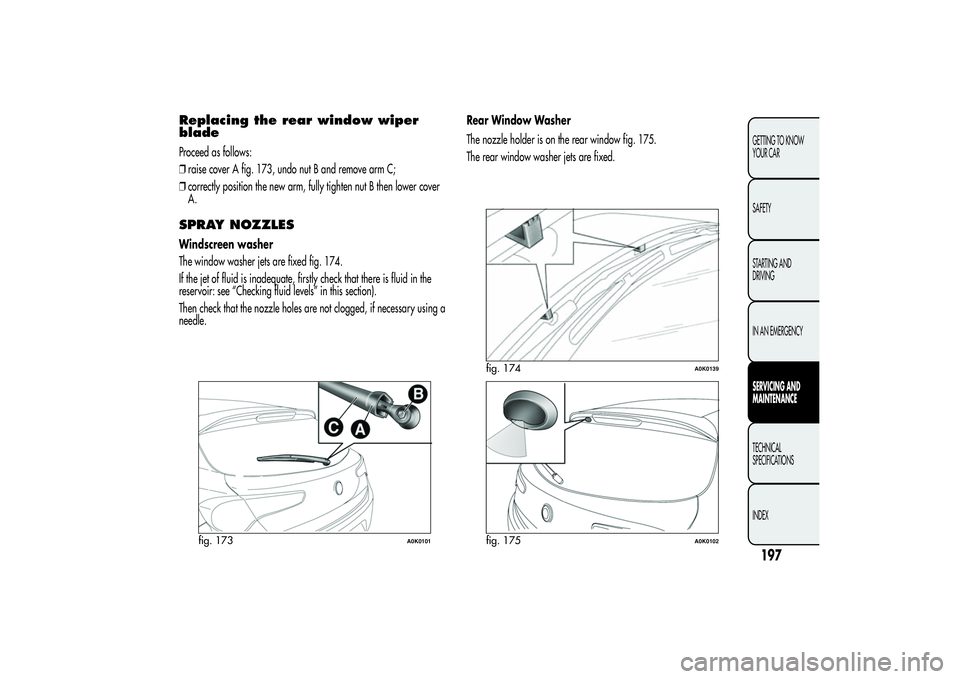
Replacing the rear window wiper
bladeProceed as follows:
❒raise cover A fig. 173, undo nut B and remove arm C;
❒correctly position the new arm, fully tighten nut B then lower cover
A.SPRAY NOZZLESWindscreen washer
The window washer jets are fixed fig. 174.
If the jet of fluid is inadequate, firstly check that there is fluid in the
reservoir: see “Checking fluid levels” in this section).
Then check that the nozzle holes are not clogged, if necessary using a
needle.Rear Window Washer
The nozzle holder is on the rear window fig. 175.
The rear window washer jets are fixed.
fig. 173
A0K0101
fig. 174
A0K0139
fig. 175
A0K0102
197GETTING TO KNOW
YOUR CAR
SAFETY
STARTING AND
DRIVING
IN AN EMERGENCYSERVICING AND
MAINTENANCETECHNICAL
SPECIFICATIONS
INDEX
Page 202 of 292
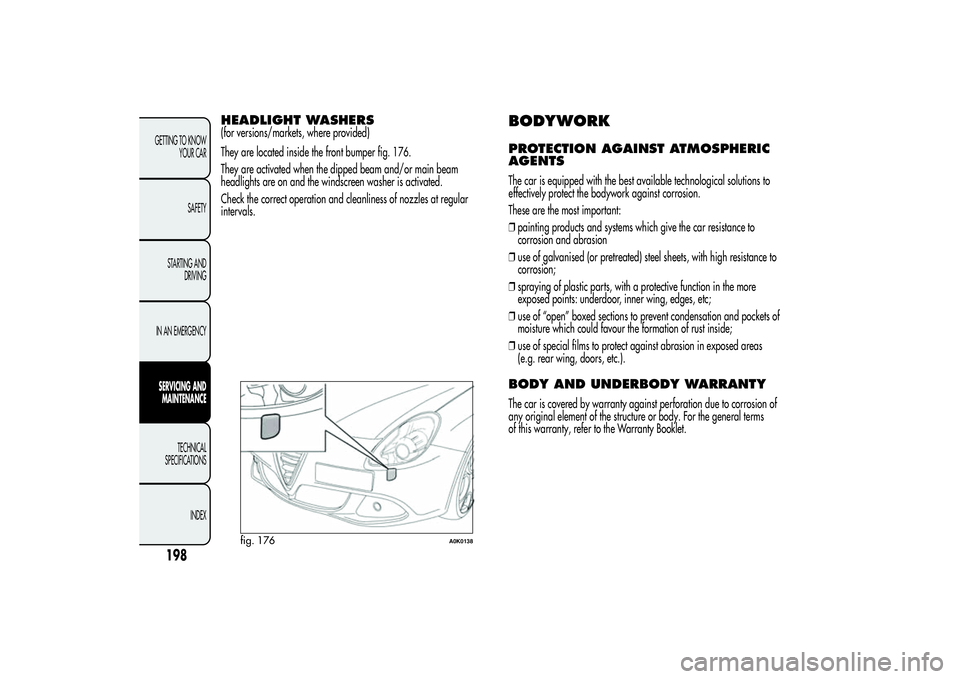
HEADLIGHT WASHERS(for versions/markets, where provided)
They are located inside the front bumper fig. 176.
They are activated when the dipped beam and/or main beam
headlights are on and the windscreen washer is activated.
Check the correct operation and cleanliness of nozzles at regular
intervals.
BODYWORKPROTECTION AGAINST ATMOSPHERIC
AGENTSThe car is equipped with the best available technological solutions to
effectively protect the bodywork against corrosion.
These are the most important:
❒painting products and systems which give the car resistance to
corrosion and abrasion
❒use of galvanised (or pretreated) steel sheets, with high resistance to
corrosion;
❒spraying of plastic parts, with a protective function in the more
exposed points: underdoor, inner wing, edges, etc;
❒use of “open” boxed sections to prevent condensation and pockets of
moisture which could favour the formation of rust inside;
❒use of special films to protect against abrasion in exposed areas
(e.g. rear wing, doors, etc.).BODY AND UNDERBODY WARRANTYThe car is covered by warranty against perforation due to corrosion of
any original element of the structure or body. For the general terms
of this warranty, refer to the Warranty Booklet.
fig. 176
A0K0138
198GETTING TO KNOW
YOUR CAR
SAFETY
STARTING AND
DRIVING
IN AN EMERGENCYSERVICING AND
MAINTENANCE
TECHNICAL
SPECIFICATIONS
INDEX
Page 203 of 292
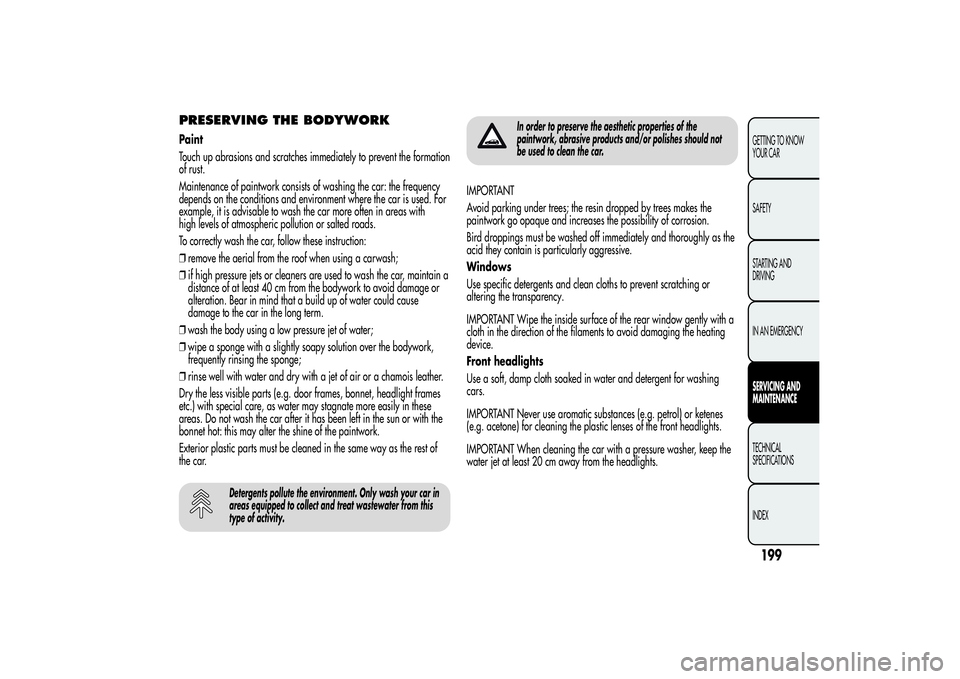
PRESERVING THE BODYWORKPaint
Touch up abrasions and scratches immediately to prevent the formation
of rust.
Maintenance of paintwork consists of washing the car: the frequency
depends on the conditions and environment where the car is used. For
example, it is advisable to wash the car more often in areas with
high levels of atmospheric pollution or salted roads.
To correctly wash the car, follow these instruction:
❒remove the aerial from the roof when using a carwash;
❒if high pressure jets or cleaners are used to wash the car, maintain a
distance of at least 40 cm from the bodywork to avoid damage or
alteration. Bear in mind that a build up of water could cause
damage to the car in the long term.
❒wash the body using a low pressure jet of water;
❒wipe a sponge with a slightly soapy solution over the bodywork,
frequently rinsing the sponge;
❒rinse well with water and dry with a jet of air or a chamois leather.
Dry the less visible parts (e.g. door frames, bonnet, headlight frames
etc.) with special care, as water may stagnate more easily in these
areas. Do not wash the car after it has been left in the sun or with the
bonnet hot: this may alter the shine of the paintwork.
Exterior plastic parts must be cleaned in the same way as the rest of
the car.
Detergents pollute the environment. Only wash your car in
areas equipped to collect and treat wastewater from this
type of activity.
In order to preserve the aesthetic properties of the
paintwork, abrasive products and/or polishes should not
be used to clean the car.
IMPORTANT
Avoid parking under trees; the resin dropped by trees makes the
paintwork go opaque and increases the possibility of corrosion.
Bird droppings must be washed off immediately and thoroughly as the
acid they contain is particularly aggressive.
Windows
Use specific detergents and clean cloths to prevent scratching or
altering the transparency.
IMPORTANT Wipe the inside surface of the rear window gently with a
cloth in the direction of the filaments to avoid damaging the heating
device.
Front headlights
Use a soft, damp cloth soaked in water and detergent for washing
cars.
IMPORTANT Never use aromatic substances (e.g. petrol) or ketenes
(e.g. acetone) for cleaning the plastic lenses of the front headlights.
IMPORTANT When cleaning the car with a pressure washer, keep the
water jet at least 20 cm away from the headlights.
199GETTING TO KNOW
YOUR CAR
SAFETY
STARTING AND
DRIVING
IN AN EMERGENCYSERVICING AND
MAINTENANCETECHNICAL
SPECIFICATIONS
INDEX
Page 204 of 292
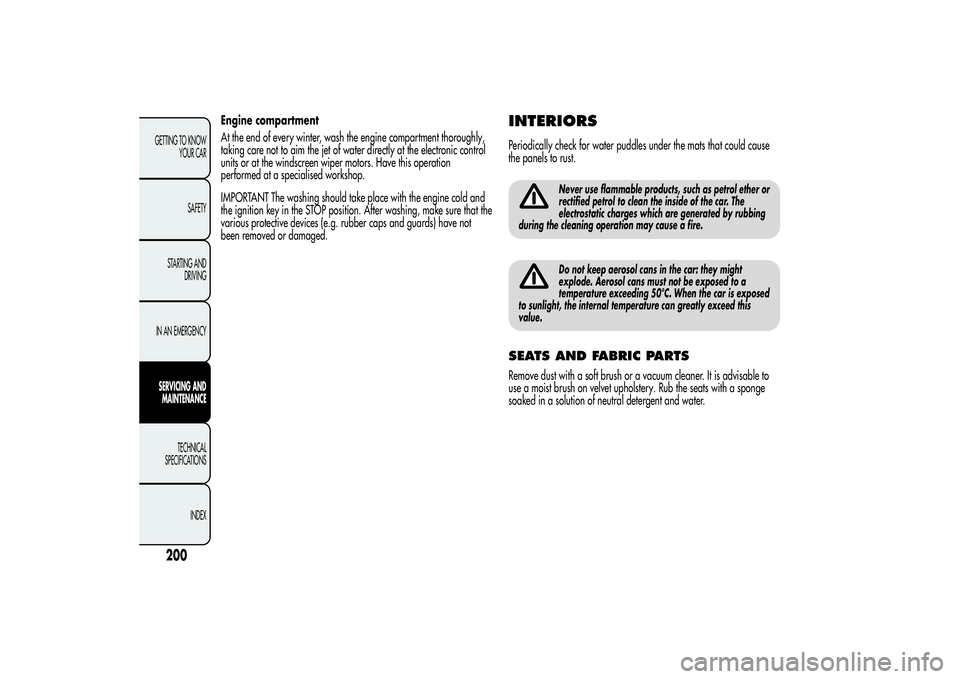
Engine compartment
At the end of every winter, wash the engine compartment thoroughly,
taking care not to aim the jet of water directly at the electronic control
units or at the windscreen wiper motors. Have this operation
performed at a specialised workshop.
IMPORTANT The washing should take place with the engine cold and
the ignition key in the STOP position. After washing, make sure that the
various protective devices (e.g. rubber caps and guards) have not
been removed or damaged.
INTERIORSPeriodically check for water puddles under the mats that could cause
the panels to rust.
Never use flammable products, such as petrol ether or
rectified petrol to clean the inside of the car. The
electrostatic charges which are generated by rubbing
during the cleaning operation may cause a fire.Do not keep aerosol cans in the car: they might
explode. Aerosol cans must not be exposed to a
temperature exceeding 50°C. When the car is exposed
to sunlight, the internal temperature can greatly exceed this
value.
SEATS AND FABRIC PARTSRemove dust with a soft brush or a vacuum cleaner. It is advisable to
use a moist brush on velvet upholstery. Rub the seats with a sponge
soaked in a solution of neutral detergent and water.
200GETTING TO KNOW
YOUR CAR
SAFETY
STARTING AND
DRIVING
IN AN EMERGENCYSERVICING AND
MAINTENANCE
TECHNICAL
SPECIFICATIONS
INDEX
Page 205 of 292
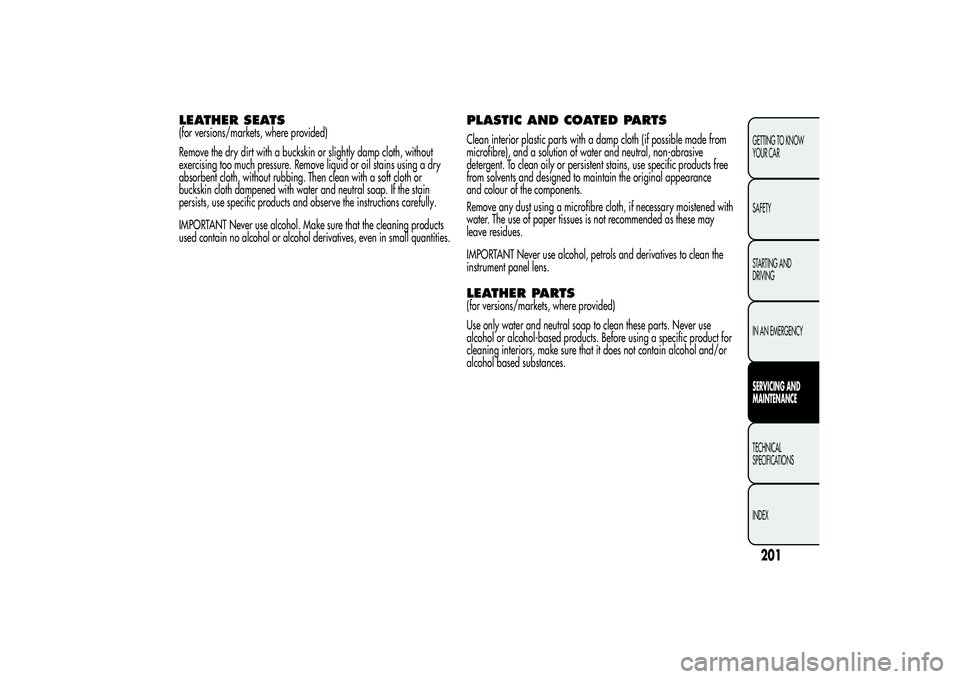
LEATHER SEATS(for versions/markets, where provided)
Remove the dry dirt with a buckskin or slightly damp cloth, without
exercising too much pressure. Remove liquid or oil stains using a dry
absorbent cloth, without rubbing. Then clean with a soft cloth or
buckskin cloth dampened with water and neutral soap. If the stain
persists, use specific products and observe the instructions carefully.
IMPORTANT Never use alcohol. Make sure that the cleaning products
used contain no alcohol or alcohol derivatives, even in small quantities.
PLASTIC AND COATED PARTSClean interior plastic parts with a damp cloth (if possible made from
microfibre), and a solution of water and neutral, non-abrasive
detergent. To clean oily or persistent stains, use specific products free
from solvents and designed to maintain the original appearance
and colour of the components.
Remove any dust using a microfibre cloth, if necessary moistened with
water. The use of paper tissues is not recommended as these may
leave residues.
IMPORTANT Never use alcohol, petrols and derivatives to clean the
instrument panel lens.LEATHER PARTS(for versions/markets, where provided)
Use only water and neutral soap to clean these parts. Never use
alcohol or alcohol-based products. Before using a specific product for
cleaning interiors, make sure that it does not contain alcohol and/or
alcohol based substances.
201GETTING TO KNOW
YOUR CAR
SAFETY
STARTING AND
DRIVING
IN AN EMERGENCYSERVICING AND
MAINTENANCETECHNICAL
SPECIFICATIONS
INDEX
Page 206 of 292
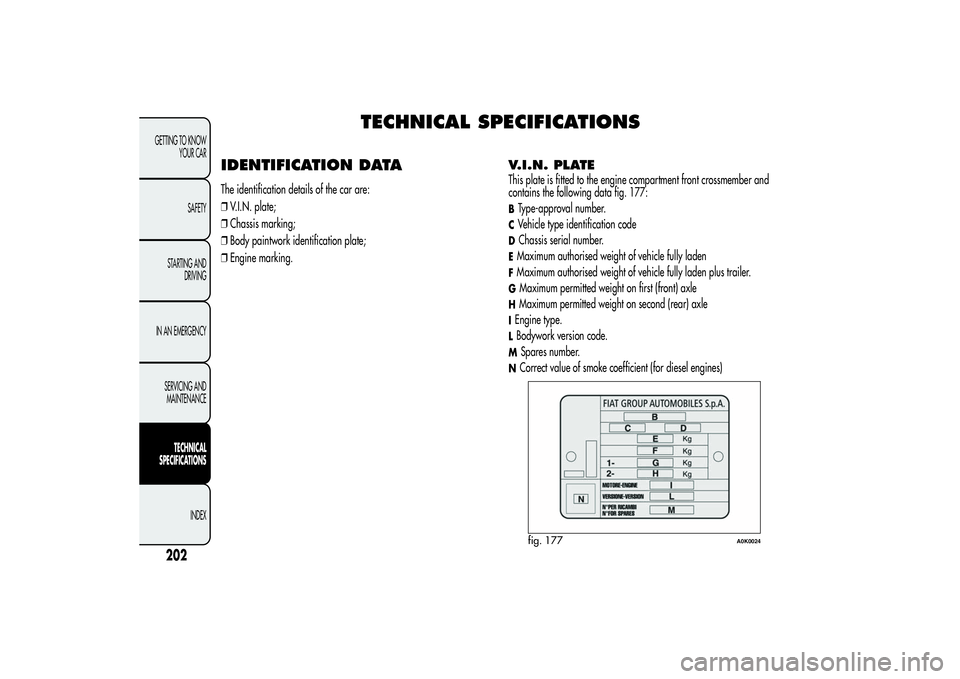
TECHNICAL SPECIFICATIONS
IDENTIFICATION DATAThe identification details of the car are:
❒V.I.N. plate;
❒Chassis marking;
❒Body paintwork identification plate;
❒Engine marking.
V.I.N. PLATEThis plate is fitted to the engine compartment front crossmember and
contains the following data fig. 177:BType-approval number.CVehicle type identification codeDChassis serial number.EMaximum authorised weight of vehicle fully ladenFMaximum authorised weight of vehicle fully laden plus trailer.GMaximum permitted weight on first (front) axleHMaximum permitted weight on second (rear) axleIEngine type.LBodywork version code.M
Spares number.
NCorrect value of smoke coefficient (for diesel engines)fig. 177
A0K0024
202GETTING TO KNOW
YOUR CAR
SAFETY
STARTING AND
DRIVING
IN AN EMERGENCY
SERVICING AND
MAINTENANCE
TECHNICAL
SPECIFICATIONS
INDEX
Page 207 of 292
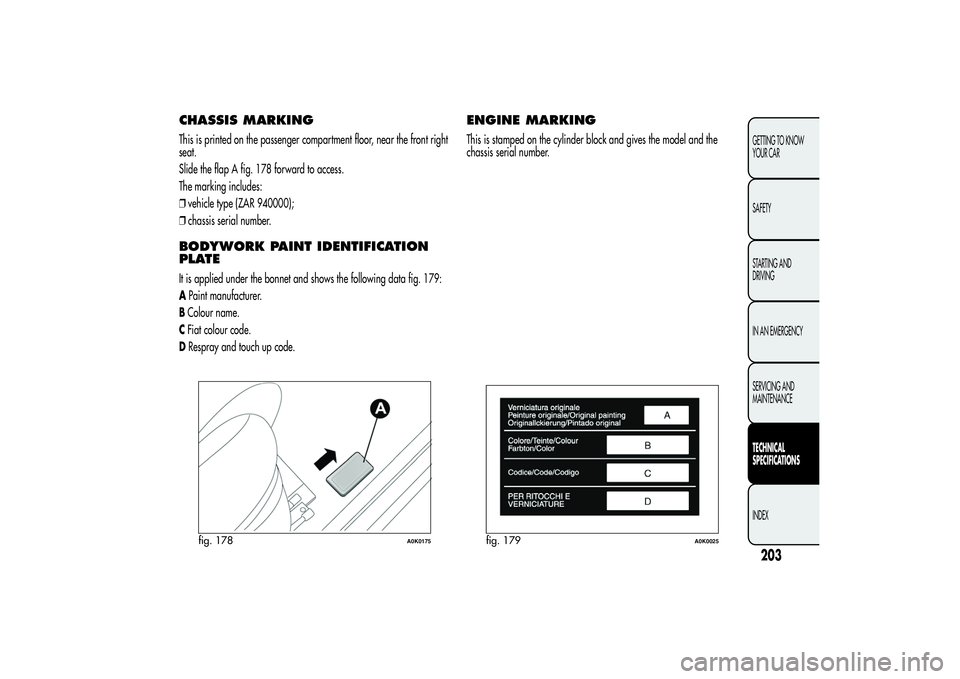
CHASSIS MARKINGThis is printed on the passenger compartment floor, near the front right
seat.
Slide the flap A fig. 178 forward to access.
The marking includes:
❒vehicle type (ZAR 940000);
❒chassis serial number.BODYWORK PAINT IDENTIFICATION
PLATEIt is applied under the bonnet and shows the following data fig. 179:
APaint manufacturer.
BColour name.
CFiat colour code.
DRespray and touch up code.
ENGINE MARKINGThis is stamped on the cylinder block and gives the model and the
chassis serial number.
fig. 178
A0K0175
fig. 179
A0K0025
203GETTING TO KNOW
YOUR CAR
SAFETY
STARTING AND
DRIVING
IN AN EMERGENCY
SERVICING AND
MAINTENANCETECHNICAL
SPECIFICATIONSINDEX
Page 208 of 292
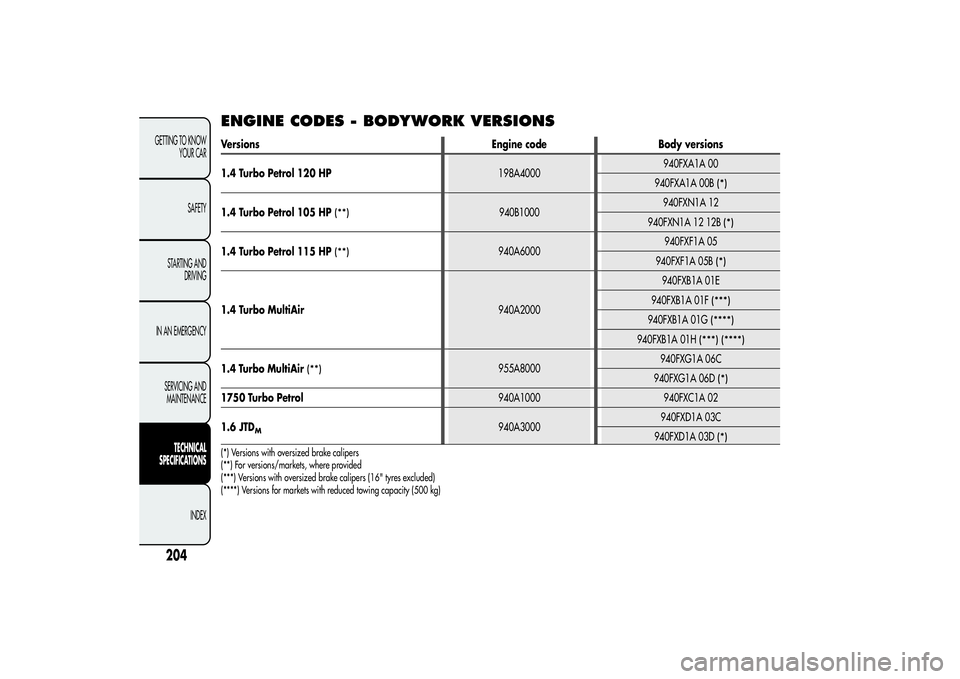
ENGINE CODES - BODYWORK VERSIONSVersions Engine code Body versions
1.4 Turbo Petrol 120 HP198A4000940FXA1A 00
940FXA1A 00B
(*)
1.4 Turbo Petrol 105 HP
(**)
940B1000940FXN1A 12
940FXN1A 12 12B
(*)
1.4 Turbo Petrol 115 HP
(**)
940A6000940FXF1A 05
940FXF1A 05B
(*)
1.4 Turbo MultiAir940A2000940FXB1A 01E
940FXB1A 01F
(***)
940FXB1A 01G
(****)
940FXB1A 01H
(***) (****)
1.4 Turbo MultiAir
(**)
955A8000940FXG1A 06C
940FXG1A 06D
(*)
1750 Turbo Petrol940A1000 940FXC1A 02
1.6 JTD
M
940A3000940FXD1A 03C
940FXD1A 03D
(*)
(*) Versions with oversized brake calipers
(**) For versions/markets, where provided
(***) Versions with oversized brake calipers (16" tyres excluded)
(****) Versions for markets with reduced towing capacity (500 kg)
204GETTING TO KNOW
YOUR CAR
SAFETY
STARTING AND
DRIVING
IN AN EMERGENCY
SERVICING AND
MAINTENANCE
TECHNICAL
SPECIFICATIONS
INDEX
Page 209 of 292
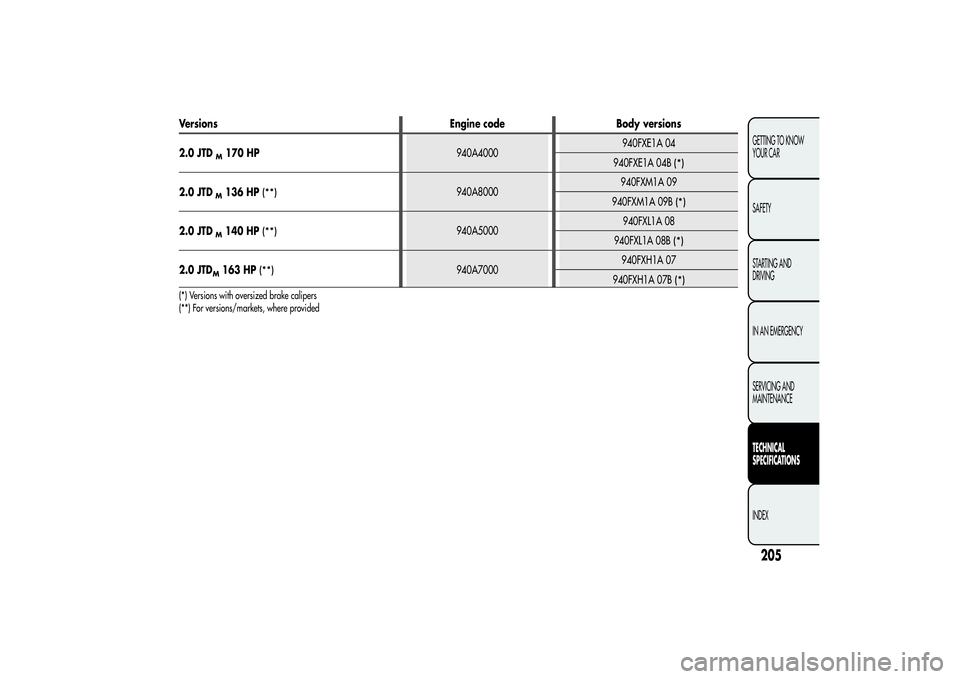
Versions Engine code Body versions
2.0 JTD
M170 HP940A4000940FXE1A 04
940FXE1A 04B
(*)
2.0 JTD
M136 HP
(**)
940A8000940FXM1A 09
940FXM1A 09B
(*)
2.0 JTD
M140 HP
(**)
940A5000940FXL1A 08
940FXL1A 08B
(*)
2.0 JTD
M163 HP
(**)
940A7000940FXH1A 07
940FXH1A 07B
(*)
(*) Versions with oversized brake calipers
(**) For versions/markets, where provided
205GETTING TO KNOW
YOUR CAR
SAFETY
STARTING AND
DRIVING
IN AN EMERGENCY
SERVICING AND
MAINTENANCETECHNICAL
SPECIFICATIONSINDEX
Page 210 of 292
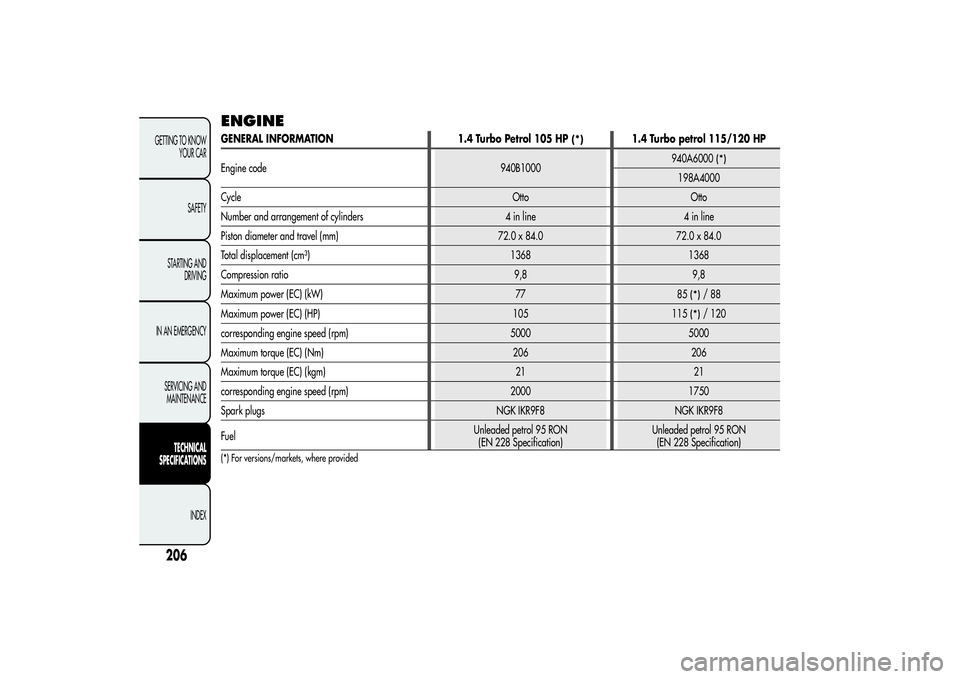
ENGINEGENERAL INFORMATION
1.4 Turbo Petrol 105 HP
(*)
1.4 Turbo petrol 115/120 HP
Engine code 940B1000940A6000
(*)
198A4000
Cycle Otto Otto
Number and arrangement of cylinders 4 in line 4 in line
Piston diameter and travel (mm) 72.0 x 84.0 72.0 x 84.0
Total displacement (cm³) 1368 1368
Compression ratio 9,8 9,8
Maximum power (EC) (kW) 77
85
(*)
/88
Maximum power (EC) (HP) 105
115
(*)
/ 120
corresponding engine speed (rpm) 5000 5000
Maximum torque (EC) (Nm) 206 206
Maximum torque (EC) (kgm) 21 21
corresponding engine speed (rpm) 2000 1750
Spark plugs NGK IKR9F8 NGK IKR9F8
FuelUnleaded petrol 95 RON
(EN 228 Specification)Unleaded petrol 95 RON
(EN 228 Specification)
(*) For versions/markets, where provided
206GETTING TO KNOW
YOUR CAR
SAFETY
STARTING AND
DRIVING
IN AN EMERGENCY
SERVICING AND
MAINTENANCE
TECHNICAL
SPECIFICATIONS
INDEX